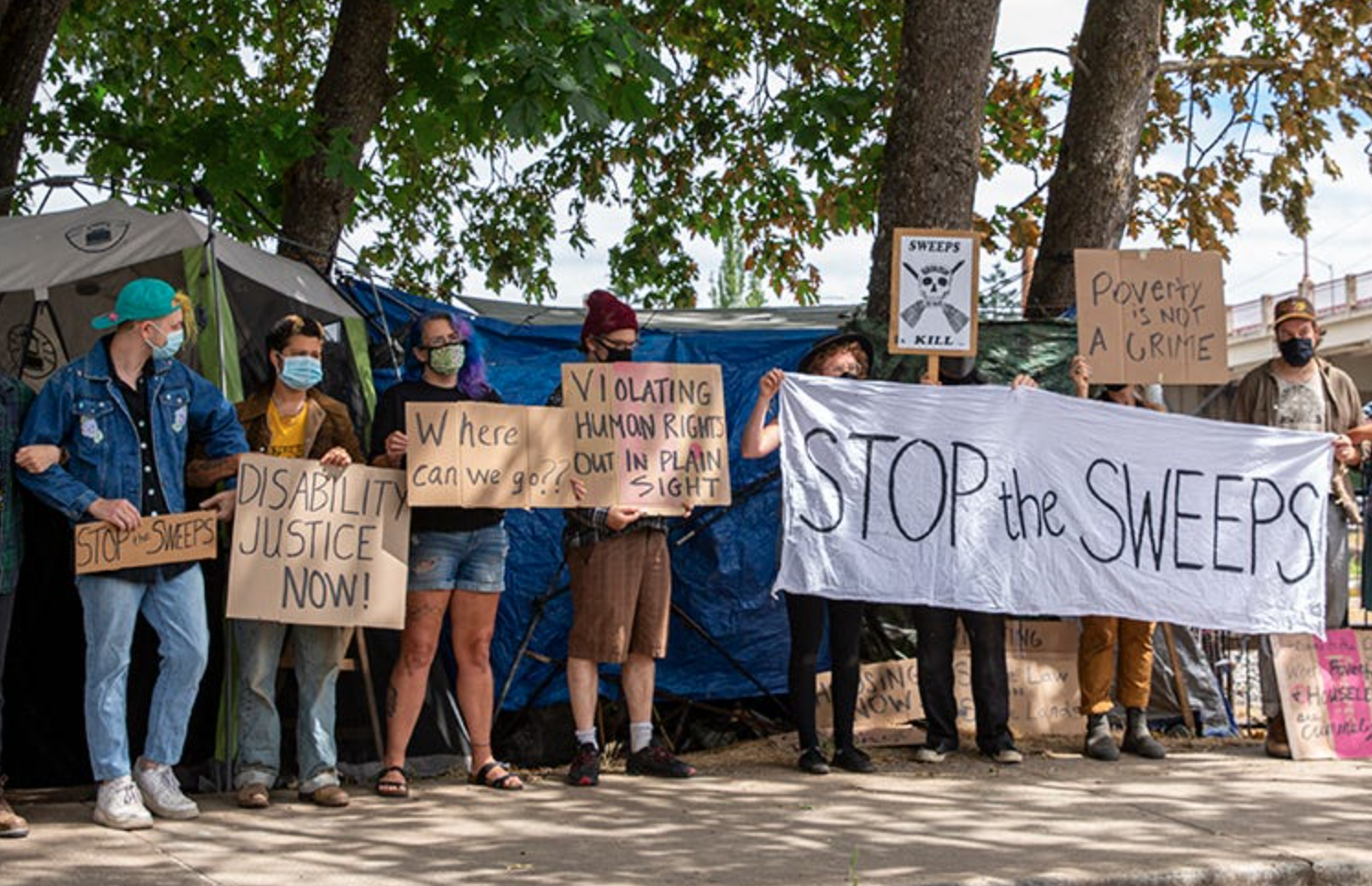A disproportionate number of unhoused pedestrians are being killed in car crashes across America — and protecting this uniquely vulnerable group will require a set of strategies that both include and exceed even the conventional street safety playbook, a new study argues.
On Friday, a group of Portland State University researchers presented their analysis of how last year's historic traffic violence impacted the houseless community in the City of Roses, and explored interventions local leaders could take to save future lives.
A shocking 70 percent of pedestrians killed in the city last year did not have a permanent residence, a statistic that the team attributes to a 37-percent county-wide spike in the number of houseless individuals across over the course of the pandemic, well as the particularly dangerous street conditions and hostile policies which they're too often forced to navigate.
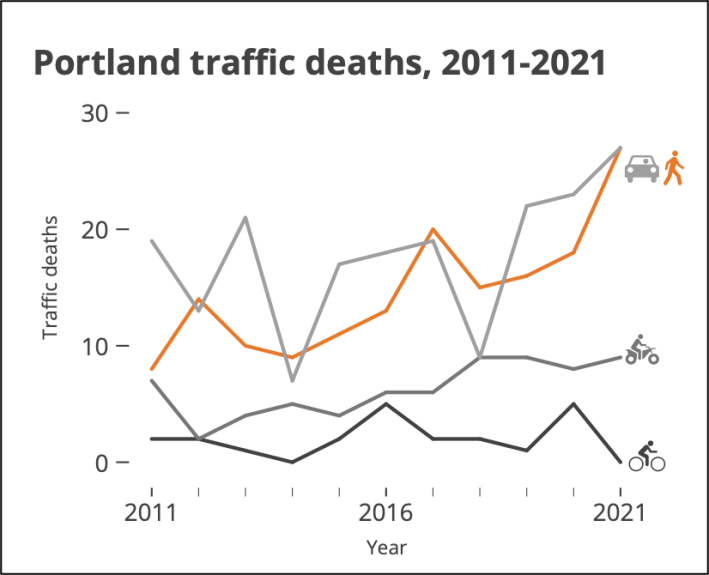
That troubling trend, though, is not unique to Oregon — nor did it begin during the days of COVID-19.
Journalists in communities as far flung as Colorado Springs and San Jose have reported on the alarming percentage of houseless people represented among their cities' pedestrian death statistics; one San Francisco article noted that "homeless people make up less than 1 percent of the city’s population, yet account for 22 percent of recent traffic deaths." An analysis of three years of pedestrian deaths in the county surrounding Las Vegas, meanwhile, found that unhoused pedestrians were 21 times more likely to die in crash than residents with a stable roof over their head, and 27 times more likely to be killed than a Sin City visitor.
In most of America, though, walking deaths among unhoused people go uncounted entirely. Federal crash reporting standards do not encourage police departments to confirm the housing status of pedestrians killed on U.S. roads, nor do they require them to report those findings to federal databases when they do record that data, making it functionally impossible to even estimate just how many dead walkers nationwide belong to these vulnerable communities.
Researchers interested in the leading causes of death for unhoused people, meanwhile, sometimes collapse traffic crashes into the general category of "accidents," or list them as "transportation-related" fatalities, rather than distinguishing them by mode — in part because, for people living on the street, traffic deaths don't always occur during the act of transportation at all. In a particularly horrifying recent crash in nearby Salem, Ore., four people were killed when an alleged drunk driver ran into their campsite at 2 a.m., presumably while many of them slept.
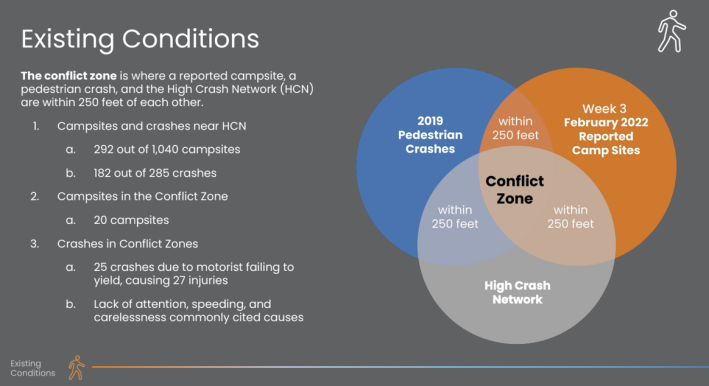
To understand how Portland could do a better job of protecting houseless people from traffic violence — and perhaps chart a model for analysis other communities could follow — the Portland State researchers conducted dozens of interviews, in addition to performing spatial analysis on fatal crash sites that sat within 250 feet of both 1) a reported campsite for unhoused people, and 2) a segment of the city's High Crash Network, where most of Portland's vehicle collisions occur.
Those overlaps weren't hard to find. In large part because of Portland's controversial policy of clearing campsites — particularly from segments of town with safe, walkable infrastructure — members of the unhoused community who either don't or can't use the narrow range of available shelter services often end up concentrated along dangerous, auto-centric corridors, some of which are among the only spaces that offer them any access to restrooms, transit lines, and other essentials.
"With sweeps and neighborhood violence increasing, the only places for our guests to go that they can be guaranteed some level of consistency with their housing is the places that put them at risk, where there aren't housed neighbors there to mess with them," one service provider told the researchers.
The absence of housed neighbors, though, often means a preponderance of fast vehicle traffic. All but one of the interviewees in the study reported that they'd experienced being struck or nearly struck by a driver, and some of those violent encounters weren't just a function of bad transportation choices — they were clear hate crimes, even if the law doesn't yet recognize them as such.
"[Some unhoused people have had] people purposely targeting them, or even speeding up towards them," said Meisha Whyte, a member of the research team. "Especially during these last two years of covid, the erratic behavior performed through driving has skyrocketed."
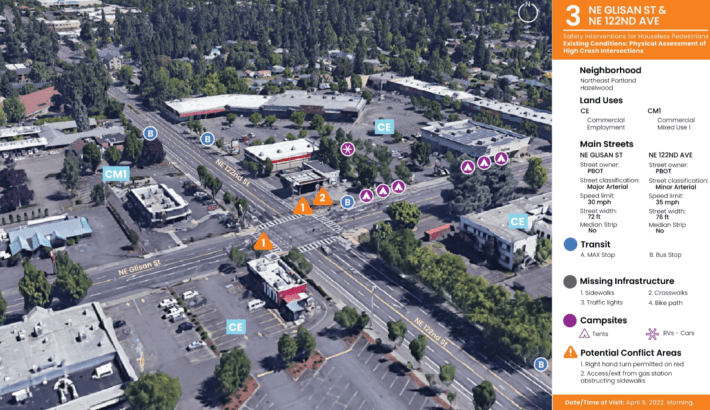
In the months since the study began, though, houseless people have found themselves increasingly unwelcome even near the most dangerous roads. Even before the 2021 fatality numbers were released, Portland Mayor Ted Wheeler was already drafting legislation to ban campsites from areas next to the High Crash Network and freeways — a move which advocates say will do little besides disperse residents to far-flung places where service providers can't find them, often forcing campers to abandon their belongings and communities of friends and family upon which they've come to rely.
In an open letter to the mayor's office, a coalition of advocates pointed out that it is illegal under Oregon law to prohibit camping on public property when there isn't enough shelter space available for everyone — which advocates say there isn't — and that "95 percent of unsheltered Portlanders said city workers didn’t [even] offer shelter before camp sweeps."
"The presence of unhoused people does not make our streets unsafe," the authors added. "Rather, poor roadway design, ongoing neglect and deferred maintenance, recklessness in the form of speeding, operating a vehicle while impaired by drugs or alcohol, and other dangerous driving behavior are all well-documented reasons why there is this alarming uptick in deaths. ... Nowhere in any transportation study, advocacy campaign or community forum seeking to address our roadway safety problems has it been suggested that unhoused people and encampments should be swept or outright banned as a partial solution to this crisis."
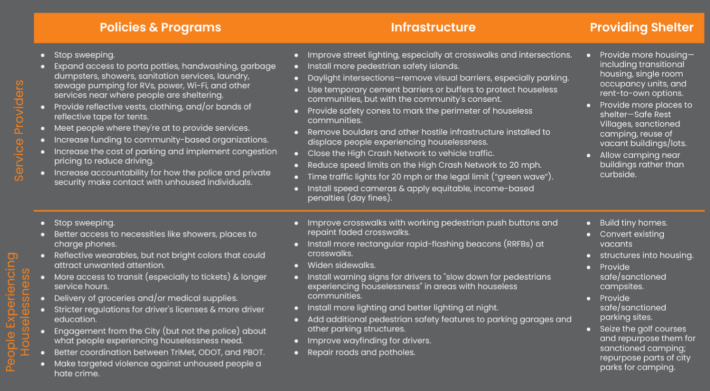
The Portland researchers agreed that the first step to reaching Vision Zero in the unhoused community must be to stop the sweeps that would remove them from dangerous environments with nowhere else to go, and focus on creating safer environments where people can live with dignity.
That means, first and foremost, housing people in accommodations that meet their unique needs — which the researchers emphasized are as individual as Portlanders themselves, not all of whom are well-served by existing shelter options. For some, a better alternative might be accessing wraparound services brought directly to existing camp sites, so residents don't have to cross deadly roads to reach them; for others, that might mean living in new, city-sanctioned structures in parks or other public lands, or out of cars or RVs parked in city-designated lots near hygiene stations.
For those for whom even those unconventional options aren't workable, though, the PSU team stressed that calming the dangerous streets where houseless people move most is paramount, and that the city should think big. In addition to improving lighting and dramatically lowering speed limits through self-enforcing road designs near the campsites and bottle drop locations that many unhoused people frequent, advocates say Portland should consider closing the entire High Crash Network to vehicle traffic altogether, much as the city has done on other streets throughout the pandemic for the benefit of housed residents.
"We see Portland closing down sections of streets so that you can eat at a restaurant ... There are sections of streets closed for residents to bike around safely," said Nick Meusch, another member of the research team. "It's a matter of doing that for everyone, and not just the people who have the power and access."
Even when streets aren't closed to vehicle traffic, though, Meusch and the other researchers emphasize that they must be re-designed to the highest standards of accessibility. It's estimated that about one-quarter of chronically houseless people identify as people with disabilities, and that isn't taking into account the sometimes disabling effects of sleep deprivation, hunger, addiction, racial weathering, and other conditions that are highly associated with houselessness itself.
Of course all those conditions exist among housed populations, too — which is all the more reason to focus on systemically reimagining our streets, rather than "perfecting" the behavior of individuals, particularly those experiencing the trauma of not having stable access to shelter.
"Fundamentally, houseless people don't move around the streets differently just because they don't have a house," said Sean Doyle, another member of the research team. "But they are outside almost all of the time, so they just have a much higher chance of being hit and killed — especially when they have been left no other place to go except for these really dangerous locations."
